Space Wars
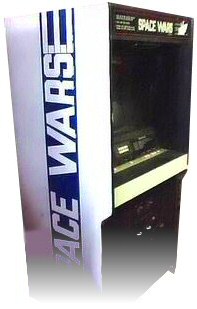 The Game: Two ships are locked in deadly deep-space combat, firing interplanetary ordnance at each other. Some variations include a sun whose gravity well will draw the immobile or the unwary to their destruction, or a roaming asteroid which can be a handy shield one moment and a killer obstacle the next. Whoever survives the most confrontations within a set amount of time is the victor. (Cinematronics, 1978)
The Game: Two ships are locked in deadly deep-space combat, firing interplanetary ordnance at each other. Some variations include a sun whose gravity well will draw the immobile or the unwary to their destruction, or a roaming asteroid which can be a handy shield one moment and a killer obstacle the next. Whoever survives the most confrontations within a set amount of time is the victor. (Cinematronics, 1978)
Memories: Packaged in a mammoth, industrial-fridge-sized cabinet, Space Wars may be imposing, but it’s hardly original. Larry Rosenthal, creator of the so-called “Vectorbeam” technology, picked a well-worn computer gaming icon that was fun, strategic…and in the public domain. [read more]

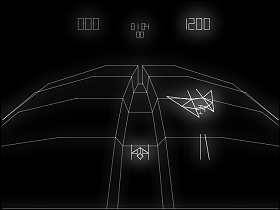 The Game: The player pilots a space fighter into an endless dogfight above a space station trench. Enemy ships attack from all directions, and even zip down the trench; and and all of these can be blasted into bits for points. Beware the fastest of these enemy fighters, which will appear with very little notice and fire directly at the player’s score, relieving it of points every time the fighter is successful with its attack! (Cinematronics, 1979)
The Game: The player pilots a space fighter into an endless dogfight above a space station trench. Enemy ships attack from all directions, and even zip down the trench; and and all of these can be blasted into bits for points. Beware the fastest of these enemy fighters, which will appear with very little notice and fire directly at the player’s score, relieving it of points every time the fighter is successful with its attack! (Cinematronics, 1979) The Game: Two armored knights coalesce out of thin air in an enclosed arena, swords at the ready. Before they can do battle, there’s the matter of simply navigating the arena’s geography: a pair of bottomless pits can lead either knight to his death, and each pit is surrounded on two sides by a staircase than can make for a handy resting place – or an even deadlier place to duel. There’s also a narrow catwalk between the pits. If the knights can stay on firm ground, the sword-swinging begins; when a knight is vanquished, he re-forms in the corner where he first appeared and can charge into battle again until he has lost all of his lives. Whoever’s still standing at the end of the game wins. (Cinematronics/Vectorbeam, 1979)
The Game: Two armored knights coalesce out of thin air in an enclosed arena, swords at the ready. Before they can do battle, there’s the matter of simply navigating the arena’s geography: a pair of bottomless pits can lead either knight to his death, and each pit is surrounded on two sides by a staircase than can make for a handy resting place – or an even deadlier place to duel. There’s also a narrow catwalk between the pits. If the knights can stay on firm ground, the sword-swinging begins; when a knight is vanquished, he re-forms in the corner where he first appeared and can charge into battle again until he has lost all of his lives. Whoever’s still standing at the end of the game wins. (Cinematronics/Vectorbeam, 1979)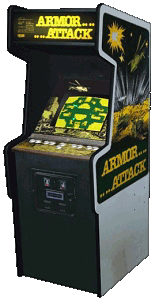 The Game: One or two players are at the controls of speedy ground assault vehicles which can zip around an enclosed maze of open areas and buildings with almost mouse-like speed. Heavy tanks and armed helicopters routinely appear in this maze, attempting to shoot any player vehicles they spot; the player(s) can, in turn, fire back at both of these vehicles. Caution: a damaged tank may still be able to draw a bead, so it’s best to keep firing until the tanks are completely destroyed. (Cinematronics, 1980)
The Game: One or two players are at the controls of speedy ground assault vehicles which can zip around an enclosed maze of open areas and buildings with almost mouse-like speed. Heavy tanks and armed helicopters routinely appear in this maze, attempting to shoot any player vehicles they spot; the player(s) can, in turn, fire back at both of these vehicles. Caution: a damaged tank may still be able to draw a bead, so it’s best to keep firing until the tanks are completely destroyed. (Cinematronics, 1980)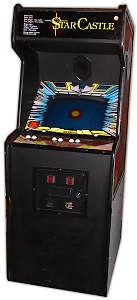 The Game: You control a lone space fighter in the immediate vicinity of the nearly-impenetrable Star Castle. Its three layers of shields rotate, but those layers aren’t solid, so you might be able to get a shot in and destroy the alien craft at its center – but it’s also just as likely that the alien will get a clear shot at you…and its firepower is far greater. (Cinematronics, 1980)
The Game: You control a lone space fighter in the immediate vicinity of the nearly-impenetrable Star Castle. Its three layers of shields rotate, but those layers aren’t solid, so you might be able to get a shot in and destroy the alien craft at its center – but it’s also just as likely that the alien will get a clear shot at you…and its firepower is far greater. (Cinematronics, 1980)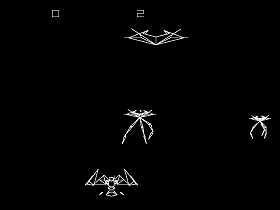 The Game: The Martians are coming! And they’re coming in colorful vector graphics! The tripod-like Martian War Machines land, extend their legs, and begin marching inexorably toward your cannon, pausing momentarily to sweep the bottom of the screen with their deadly heat rays, or hurling spirals of energy your way to slow down your cannon. You have a shield that can offer you mere moments of protection, but if it wears out or you find yourself in the Martians’ sights, your spiky-headed cannon operator is fried, and the cannon is promptly manned by another spiky-headed gunner. When your spiky-headed infantry is exhausted, the Martian invasion continues… (Cinematronics, 1981)
The Game: The Martians are coming! And they’re coming in colorful vector graphics! The tripod-like Martian War Machines land, extend their legs, and begin marching inexorably toward your cannon, pausing momentarily to sweep the bottom of the screen with their deadly heat rays, or hurling spirals of energy your way to slow down your cannon. You have a shield that can offer you mere moments of protection, but if it wears out or you find yourself in the Martians’ sights, your spiky-headed cannon operator is fried, and the cannon is promptly manned by another spiky-headed gunner. When your spiky-headed infantry is exhausted, the Martian invasion continues… (Cinematronics, 1981)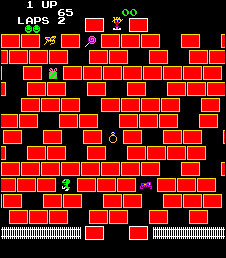 The Game: You control a hapless creature who can jump between rows of moving bricks and even temporarily build a brick around himself. You’re trying to help him gather gifts for Lola, the object of his desires, at the opposite end of the screen; she won’t even pay attention to you until you’ve accumulated a certain number of gifts for her. (Demanding, isn’t she? I can hear Dr. Phil screaming “Stay away from her! She’s bad for you!” already.) Other than Lola’s curiously materialistic outlook on life, your biggest obstacles are colorful critters who would happily jump on you and end your quest. You can hide from them temporarily by building a brick around yourself, but if they catch you, it’s time to start over again. (Cinematronics, 1982)
The Game: You control a hapless creature who can jump between rows of moving bricks and even temporarily build a brick around himself. You’re trying to help him gather gifts for Lola, the object of his desires, at the opposite end of the screen; she won’t even pay attention to you until you’ve accumulated a certain number of gifts for her. (Demanding, isn’t she? I can hear Dr. Phil screaming “Stay away from her! She’s bad for you!” already.) Other than Lola’s curiously materialistic outlook on life, your biggest obstacles are colorful critters who would happily jump on you and end your quest. You can hide from them temporarily by building a brick around yourself, but if they catch you, it’s time to start over again. (Cinematronics, 1982)